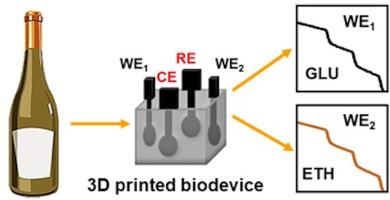3D打印用于同时测定葡萄酒中葡萄糖和乙醇的电化学双传感器生物装置
IF 6.3
1区 农林科学
Q1 FOOD SCIENCE & TECHNOLOGY
引用次数: 0
摘要
可持续和负担得起的制造和直接使用集成电化学生物传感器在需要的点设置支持分散的食品和饮料质量监测从集中的实验室。利用3D打印的数字简单性,成本效益和无需实验室的优势,我们提出了一种紧凑的,完全集成的3D打印双传感器酶生物装置,通过使用便携式双电位器进行单次分析,可同时测定葡萄酒样品中的乙醇(ETH)和葡萄糖(GLU)。该装置由四个炭黑/聚乳酸(CB/PLA)电极组成,其中两个工作电极(WEs),一个参考电极和一个反电极嵌入一个小型可生物降解的PLA电池中。每个WE都用普鲁士蓝介质层、各自的氧化酶和Nafion膜进行修饰,以实现选择性生物催化氧化,并从一滴葡萄酒中同时检测两种分析物。该方法灵敏度高(检出限为0.4 mM ETH和9.5 μM GLU),对常见干扰具有良好的选择性,重现性好,可操作性强,制备稳定性好。采用标准色谱法测定了3种葡萄酒样品中ETH和GLU的浓度。该设备可以在需要时轻松生产,结果表明其能够快速,直接,敏感和选择性地现场同时测量葡萄酒中的ETH和GLU,同时也为扩展到与食品和饮料行业相关的其他化学标记物的监测提供了前景。本文章由计算机程序翻译,如有差异,请以英文原文为准。

3D printed electrochemical dual-sensor biodevice for the simultaneous determination of glucose and ethanol in wines
The sustainable and affordable fabrication and direct use of integrated electrochemical biosensors in point of need settings support the decentralization of food and beverage quality monitoring from centralized laboratories. Leveraging the digital simplicity, cost-effectiveness, and laboratory-free advantages of 3D printing, we present a compact, fully integrated, 3D printed dual-sensor enzymatic biodevice for the simultaneous amperometric determination of ethanol (ETH) and glucose (GLU) in wine samples via a single assay using a portable bi-potentiostat. The device was fabricated through a one-step process and comprised four carbon black/polylactic acid (CB/PLA) electrodes—two working electrodes (WEs), one reference, and one counter electrode—embedded in a small biodegradable PLA cell. Each WE was modified with a Prussian Blue mediator layer, the respective oxidase enzyme, and a Nafion film to enable selective biocatalytic oxidation and simultaneous detection of both analytes from a single drop of wine. The developed method exhibited high sensitivity (limits of detection: 0.4 mM ETH and 9.5 μM GLU), excellent selectivity against common interferences, and reproducibility, confirming operational and fabrication robustness. The concentrations of ETH and GLU in three wine samples were determined and validated against standard chromatographic methods. The device can be easily produced at the point of need, and the results demonstrate its ability for rapid, direct, sensitive, and selective on-site simultaneous measurements of ETH and GLU in wines, while also offering prospects for extension to the monitoring of other chemical markers relevant to the food and beverage industry.
求助全文
通过发布文献求助,成功后即可免费获取论文全文。
去求助
来源期刊

Food Control
工程技术-食品科技
CiteScore
12.20
自引率
6.70%
发文量
758
审稿时长
33 days
期刊介绍:
Food Control is an international journal that provides essential information for those involved in food safety and process control.
Food Control covers the below areas that relate to food process control or to food safety of human foods:
• Microbial food safety and antimicrobial systems
• Mycotoxins
• Hazard analysis, HACCP and food safety objectives
• Risk assessment, including microbial and chemical hazards
• Quality assurance
• Good manufacturing practices
• Food process systems design and control
• Food Packaging technology and materials in contact with foods
• Rapid methods of analysis and detection, including sensor technology
• Codes of practice, legislation and international harmonization
• Consumer issues
• Education, training and research needs.
The scope of Food Control is comprehensive and includes original research papers, authoritative reviews, short communications, comment articles that report on new developments in food control, and position papers.
 求助内容:
求助内容: 应助结果提醒方式:
应助结果提醒方式:


